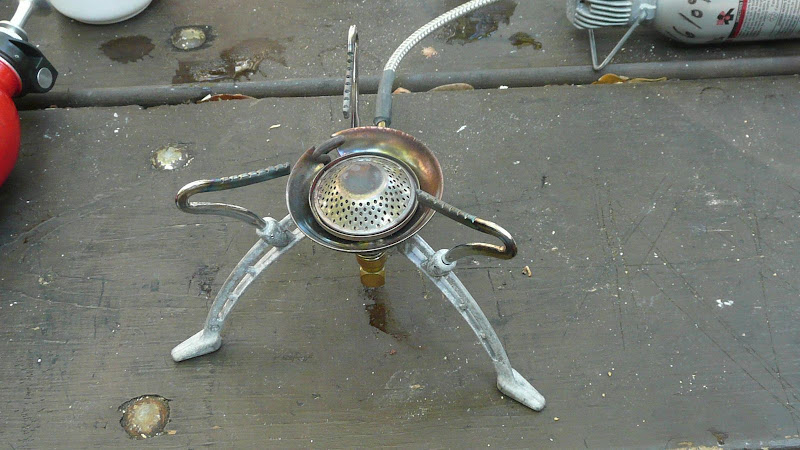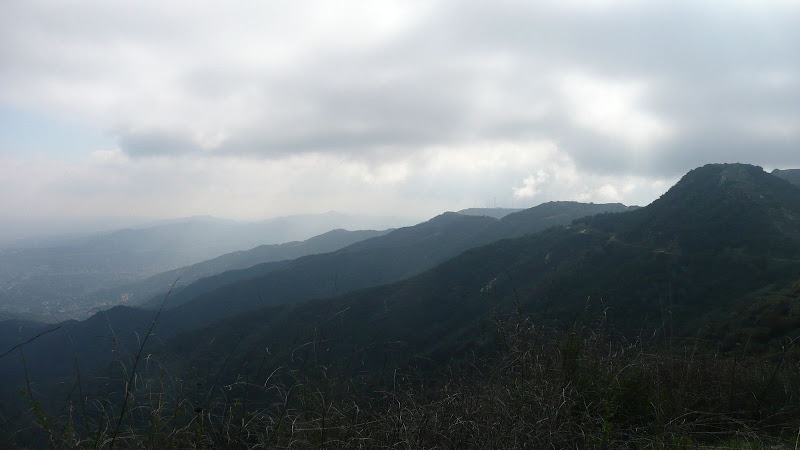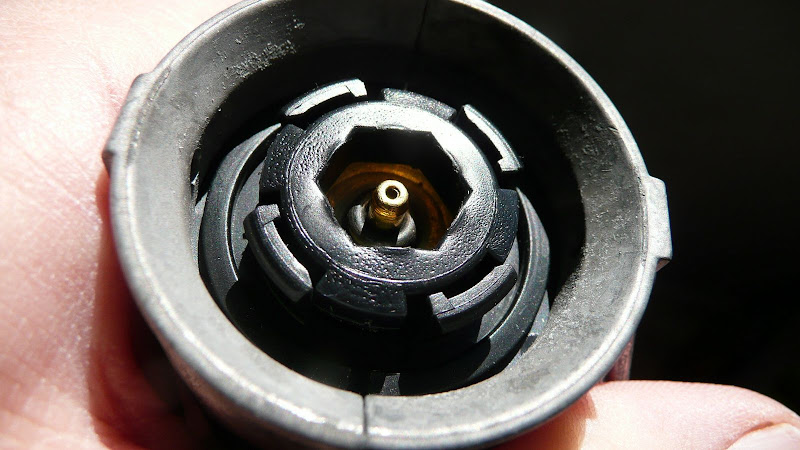Stove of the Week: MSR Simmerlite
Recently, I was asked by a mountaineering friend about ways to melt snow for drinking water that are light weight. I'm therefore posting a series within the Stove of the Week series on light weight winter capable stoves.
In that vein, this week's stove is the MSR Simmerlite. Let's start it off right with a flame shot:

Today's destination is Haines Canyon, site of much of my stove testing. I see the recent wind storm has taken its toll.

The good news is that the creek is running well which means we'll have plenty of water for use with our Simmerlite.

Now, if you're talking about cold weather capable stoves, then no discussion is complete without discussing liquid fueled stoves. Liquid fueled stoves will operate in the coldest of temperatures. To this day, explorers and researchers in Antarctica use liquid fueled stoves. The fuels used are typically "white" gasoline (Coleman type fuel) or kerosene.
Some time ago, MSR set out to create a light weight liquid fuel stove. They came up with the Simmerlite. It should be noted that the Simmerlite is a white gasoline stove only. The Simmerlite will not burn kerosene properly.

In the Simmerlite, MSR succeeded admirably in their quest for a light weight liquid fueled stove.
Then MSR made a serious mistake. They let the marketing department get a hold of it. It went something like this: "People want a stove that simmers," said the marketing department, "We'll emphasize this stove's ability to simmer by naming this stove, the Simmerlite. We'll sell thousands!"
"B-b-b-but it doesn't simmer" stammered the stove engineers. "Not even close."
"Bosh! Down with you nay-sayers!" cried the marketing department. "We've got stoves to sell and bonuses to earn! Out of our way!"
And so it was, and this engineering success became a marketing boondoggle. Instead of focusing on the Simmerlite's most valuable attribute, it's light weight, MSR damaged its reputation and created customer ill will by marketing a simmering stove -- that doesn't simmer. Well, OK, maybe it didn't go exactly like that, but surely it must have been something like that. How else to explain the word "simmer" in a stove that doesn't?
Now, the vagaries of manufacturing being what they are, there is the odd exception out there. I do know of one person whose Simmerlite actually simmers. Generally, though, the Simmerlite doesn't simmer.
So, that misconception dispelled, let's set our Simmerlite up. Here's a photo of the Simmerlite ready to go. Immediately behind the Simmerlite is her sister stove, the MSR Wind Pro which is essentially the same stove except that the Wind Pro has been modified to run on gas canisters.
But enough about the Wind Pro; the Wind Pro is next week's stove.
Here's the Simmerlite, windscreen in place, chugging along, heating water for my morning tea.

Any stove worth it's salt must pass the "tea test" (boiling water), and judging by the steam coming out of the tea kettle in this photo, I'd say the Simmerlite has passed the tea test with flying colors.

Ah! There we are. Delicious.

Now, I realize that liquid fueled stoves are perceived as challenging by some. In particular, priming seems to put people off. Really, once you get the hang of it, liquid fueled stoves are no big deal, and they'll run in as cold a temperature as you can stand. I'll talk about tips and tricks for priming liquid fueled stoves in the weeks to come.
Well, that's it for today. Time to hit the road for home.

Thank you for joining me on another adventure in stoving.
HJ
Some summary information:
What's good about it?
It really is light.
It's fairly compact.
The hose is much more flexible than previous MSR stoves.
It's liquid fueled and will work in as cold a temperature as you can stand.
Liquid fuel is the least expensive fuel, and there aren't all those "dead" canisters that have to be landfilled or recycled. Remember, while recycling is better than putting them in a land fill, recycling is still costly from an environmental standpoint.
What's bad about it?
Pumping and priming -- but really they're no big deal; they just take a little practice.
The pot supports are a little slidey. They could be a little more grippy.
It does not simmer.
Overall, the Simmerlite is a good light weight winter capable stove.
Recently, I was asked by a mountaineering friend about ways to melt snow for drinking water that are light weight. I'm therefore posting a series within the Stove of the Week series on light weight winter capable stoves.
In that vein, this week's stove is the MSR Simmerlite. Let's start it off right with a flame shot:

Today's destination is Haines Canyon, site of much of my stove testing. I see the recent wind storm has taken its toll.

The good news is that the creek is running well which means we'll have plenty of water for use with our Simmerlite.

Now, if you're talking about cold weather capable stoves, then no discussion is complete without discussing liquid fueled stoves. Liquid fueled stoves will operate in the coldest of temperatures. To this day, explorers and researchers in Antarctica use liquid fueled stoves. The fuels used are typically "white" gasoline (Coleman type fuel) or kerosene.
Some time ago, MSR set out to create a light weight liquid fuel stove. They came up with the Simmerlite. It should be noted that the Simmerlite is a white gasoline stove only. The Simmerlite will not burn kerosene properly.

In the Simmerlite, MSR succeeded admirably in their quest for a light weight liquid fueled stove.
Then MSR made a serious mistake. They let the marketing department get a hold of it. It went something like this: "People want a stove that simmers," said the marketing department, "We'll emphasize this stove's ability to simmer by naming this stove, the Simmerlite. We'll sell thousands!"
"B-b-b-but it doesn't simmer" stammered the stove engineers. "Not even close."
"Bosh! Down with you nay-sayers!" cried the marketing department. "We've got stoves to sell and bonuses to earn! Out of our way!"
And so it was, and this engineering success became a marketing boondoggle. Instead of focusing on the Simmerlite's most valuable attribute, it's light weight, MSR damaged its reputation and created customer ill will by marketing a simmering stove -- that doesn't simmer. Well, OK, maybe it didn't go exactly like that, but surely it must have been something like that. How else to explain the word "simmer" in a stove that doesn't?
Now, the vagaries of manufacturing being what they are, there is the odd exception out there. I do know of one person whose Simmerlite actually simmers. Generally, though, the Simmerlite doesn't simmer.
So, that misconception dispelled, let's set our Simmerlite up. Here's a photo of the Simmerlite ready to go. Immediately behind the Simmerlite is her sister stove, the MSR Wind Pro which is essentially the same stove except that the Wind Pro has been modified to run on gas canisters.

But enough about the Wind Pro; the Wind Pro is next week's stove.
Here's the Simmerlite, windscreen in place, chugging along, heating water for my morning tea.

Any stove worth it's salt must pass the "tea test" (boiling water), and judging by the steam coming out of the tea kettle in this photo, I'd say the Simmerlite has passed the tea test with flying colors.

Ah! There we are. Delicious.

Now, I realize that liquid fueled stoves are perceived as challenging by some. In particular, priming seems to put people off. Really, once you get the hang of it, liquid fueled stoves are no big deal, and they'll run in as cold a temperature as you can stand. I'll talk about tips and tricks for priming liquid fueled stoves in the weeks to come.
Well, that's it for today. Time to hit the road for home.

Thank you for joining me on another adventure in stoving.
HJ
Some summary information:
What's good about it?
It really is light.
It's fairly compact.
The hose is much more flexible than previous MSR stoves.
It's liquid fueled and will work in as cold a temperature as you can stand.
Liquid fuel is the least expensive fuel, and there aren't all those "dead" canisters that have to be landfilled or recycled. Remember, while recycling is better than putting them in a land fill, recycling is still costly from an environmental standpoint.
What's bad about it?
Pumping and priming -- but really they're no big deal; they just take a little practice.
The pot supports are a little slidey. They could be a little more grippy.
It does not simmer.
Overall, the Simmerlite is a good light weight winter capable stove.

















































